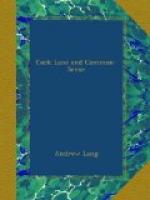Mr. K.’s version is the version given by Goldsmith, and thus leads up to the ‘phenomena’ through a romance of middle-class life. In 1756, this Mr. K., a person of some means, married Miss E. L. of L. in Norfolk. In eleven months the young wife died, in childbed, and her sister, Miss Fanny, came to keep house for Mr. K. The usual passionate desire to marry his deceased wife’s sister assailed Mr. K., and Fanny shared his flame. According to Goldsmith, the canon law would have permitted the nuptials, if the wife had not born a child which lived, though only for a few minutes. However this may be, Mr. K. honourably fled from Fanny, who, unhappily, pursued him with letters, and followed him to town. Here they took lodgings together, but when Mr. K. left the rooms, being unable to recover some money which he had lent his landlord, the pair looked out for new apartments. These they found in Cock Lane, in the house of Mr. Parsons, clerk of St. Sepulchre’s.
It chanced (here we turn to the Annual Register for 1762) that Mr. K. left Fanny alone in Cock Lane while he went to a wedding in the country. She asked little Elizabeth Parsons, her landlord’s daughter, to share her bed, and both of them were disturbed by strange scratchings and rappings. These were attributed by Mrs. Parsons to the industry of a neighbouring cobbler, but when they occurred on a Sunday, this theory was abandoned. Poor Fanny, according to the newspapers, thought the noises were a warning of her own death. Others, after the event, imagined that they were caused by the jealous or admonishing spirit of her dead sister. Fanny and Mr. K. (having sued Mr. Parsons for money lent) left his rooms in dudgeon, and went to Bartlet Court, Clerkenwell. Here Fanny died on February 2, 1760, of a disease which her physician and apothecary certified to be small-pox, and her coffin was laid in the vault of St. John’s Church. Now the noises in Cock Lane had ceased for a year and a half after Fanny left the house, but they returned in force in 1761-62. Mr. Parsons in vain took down the wainscotting, to see whether some mischievous neighbour produced the sounds. {165} The raps and scratches seemed to come on the bed of little Elizabeth Parsons, just as in the case of the Tedworth drummer, investigated by Glanvill, a hundred years earlier; and in the case at Orleans, 230 years earlier. The Orleans case is published, with full legal documents, from MS. 40, 7170, 4, Bibliotheque du Roi, in Recueil de Dissertations Anciennes et Nouvelles sur les Apparitions, ii. 90 (a Avignon, 1751). ‘Scratching’ was usually the first manifestation in this affair, and the scratches were heard in the bedroom occupied by certain children. The Cock Lane child ’was always affected with tremblings and shiverings at the coming and going of the ghost’. It was stated that the child had seen a shrouded figure without hands; two other witnesses (one of them a publican) had seen a luminous apparition, with




